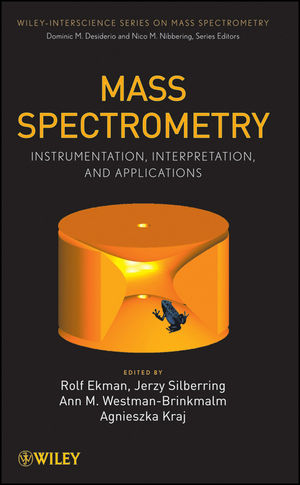Mass Spectrometry: Instrumentation, Interpretation, and ApplicationsISBN: 978-0-471-71395-1
Hardcover
388 pages
December 2008
 This is a Print-on-Demand title. It will be printed specifically to fill your order. Please allow an additional 15-20 days delivery time. The book is not returnable.
|
||||||
CONTRIBUTORS.
PART I INSTRUMENTATION.
1 DEFINITIONS AND EXPLANATIONS (Ann Westman-Brinkmalm and Gunnar Brinkmalm).
References.
2 A MASS SPECTROMETER’S BUILDING BLOCKS (Ann Westman-Brinkmalm and Gunnar Brinkmalm).
2.1. Ion Sources.
2.2. Mass Analyzers.
2.3. Detectors.
References.
3 TANDEM MASS SPECTROMETRY (Ann Westman-Brinkmalm and Gunnar Brinkmalm).
3.1. Tandem MS Analyzer Combinations.
3.2. Ion Activation Methods.
References.
4 SEPARATION METHODS (Ann Westman-Brinkmalm, Jerzy Silberring, and Gunnar Brinkmalm).
4.1. Chromatography.
4.2. Electric-Field Driven Separations.
References.
PART II INTERPRETATION.
5 INTRODUCTION TO MASS SPECTRA INTERPRETATION: ORGANIC CHEMISTRY (Albert T. Lebedev).
5.1. Basic Concepts.
5.2. Inlet Systems.
5.3. Physical Bases of Mass Spectrometry.
5.4. Theoretical Rules and Approaches to Interpret Mass Spectra.
5.5. Practical Approaches to Interpret Mass Spectra.
References.
6 SEQUENCING OF PEPTIDES AND PROTEINS (Marek Noga, Tomasz Dylag, and Jerzy Silberring).
6.1. Basic Concepts.
6.2. Tandem Mass Spectrometry of Peptides and Proteins.
6.3. Peptide Fragmentation Nomenclature.
6.4. Technical Aspects and Fragmentation Rules.
6.5. Why Peptide Sequencing?
6.6. De Novo Sequencing
6.7. Peptide Derivatization Prior to Fragmentation.
Acknowledgments.
References.
Online Tutorials.
7 OPTIMIZING SENSITIVITY AND SPECIFICITY IN MASS SPECTROMETRIC PROTEOME ANALYSIS (Jan Eriksson and David Fenyö).
7.1. Quantitation.
7.2. Peptide and Protein Identification.
7.3. Success Rate and Relative Dynamic Range.
7.4. Summary.
References.
PART III APPLICATIONS.
8 DOPING CONTROL (Graham Trout).
References.
9 OCEANOGRAPHY (R. Timothy Short, Robert H. Byrne, David Hollander, Johan Schijf, Strawn K. Toler, and Edward S. VanVleet).
References.
10 “OMICS” APPLICATIONS (Simone Koñig).
10.1. Introduction.
10.2. Genomics and Transcriptomics.
10.3. Proteomics.
10.4. Metabolomics.
11 SPACE SCIENCES (Robert Sheldon).
11.1. Introduction.
11.2. Origins.
11.3. Dynamics.
11.4. The Space MS Paradox.
11.5. A Brief History of Space MS.
11.6. GENESIS and the Future.
References.
12 BIOTERRORISM (Vito G. DelVecchio and Cesar V.
Mujer).
12.1. What is Bioterrorism?
12.2. Some Historical Accounts of Bioterrorism.
12.3. Geneva Protocol of 1925 and Biological Weapons Convention of 1972.
12.4. Categories of Biothreat Agents.
12.5. Challenges.
12.6. MS Identification of Biomarker Proteins.
12.7. Development of New Therapeutics and Vaccines Using Immunoproteomics.
References.
13 IMAGING OF SMALL MOLECULES (Małgorzata Iwona Szynkowska).
13.1. SIMS Imaging.
13.2. Biological Applications (Cells, Tissues, and Pharmaceuticals).
13.3. Catalysis.
13.4. Forensics.
13.5. Semiconductors.
13.6. The Future.
References.
14 UTILIZATION OF MASS SPECTROMETRY IN CLINICAL CHEMISTRY (Donald H. Chace).
14.1. Introduction.
14.2. Where are Mass Spectrometers Utilized in Clinical Applications?
14.3. Most Common Analytes Detected by Mass Spectrometers.
14.4. Multianalyte Detection of Clinical Biomarkers, The Real Success Story.
14.5. Quantitative Profiling.
14.6. A Clinical Example of the Use of Mass Spectrometry.
14.7. Demonstrations of Concepts of Quantification in Clinical Chemistry.
15 POLYMERS (Maurizio S. Montaudo).
15.1. Introduction.
15.2. Instrumentation, Sample Preparation, and Matrices.
15.3. Analysis of Ultrapure Polymer Samples.
15.4. Analysis of Polymer Samples in which all Chains Possess the Same Backbone.
15.5. Analysis of Polymer Mixtures with Different Backbones.
15.6. Determination of Average Molar Masses.
References.
16 FORENSIC SCIENCES (Maria Kala).
16.1. Introduction.
16.2. Materials Examined and Goals of Analysis.
16.3. Sample Preparation.
16.4. Systematic Toxicological Analysis.
16.5. Quantitative Analysis.
16.6. Identification of Arsons.
References.
17 NEW APPROACHES TO NEUROCHEMISTRY (Jonas Bergquist, Jerzy Silberring, and Rolf Ekman).
17.1. Introduction.
17.2. Why is there so Little Research in this Area?
17.3. Proteomics and Neurochemistry.
17.4. Conclusions.
Acknowledgments.
References.
PART IV APPENDIX.
INDEX.



